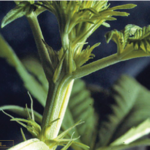The close image of Asian Ticks
- The Asian long-horned tick, scientifically known as Haemaphysalis longicornis belongs to the Animalia kingdom. Its bites can potentially harm humans and other animals.
- They live in many Asian countries like China, Japan, the Russian Far East and Korea. They aren’t directly harmful to animals and humans but, they can spread harmful germs that cause serious illness.
- They are not normally seen in the western hemisphere. However, some news reports have covered the presence of Asian Ticks in the United States. The local people have spotted them in their farming land where vegetables and other essential crops cultivating.
- The adult Asian longhorn ticks are small creatures up to 0.1 inches(2.5mm) long with a reddish-brown colour. When they fully grow up, they get the size of a pea. They have no distinct colour or markings, unlike the native ticks. Sometimes, identifying the native ticks and Asian ticks is confusing for many.
- Their life is composed of three stages- a six-legged larva stage, an eight-legged nymph stage and an adult stage. And the Asian ticks don’t fly or jump.
Asian ticks in the US spreading worries
The eight-legged Asian ticks
- They are found on pets, livestock, wildlife and people. The female ticks can lay eggs and reproduce without mating increasing the possibility of more new generation ticks. This process is called Parthenogenesis. Male ticks are rare and female ticks enjoy freedom by producing more eggs. The close observation found that they can lay up to 25,00 eggs in the late spring to early summer.
- They are a together-creature and thousands of ticks can be found on grass or animal at one time. Researchers are studying the physical features of Asian Ticks to better understand their journey to the US and the preferable life setting.
- The Asian Ticks seem less attractive compared to the native ticks of the US. It is not evident that these ticks can directly make humans ill. The studies over the years conducted have identified that they spread harmful germs through their biting.
- It is also believed that they have caused heavy fever in Japan and other Asian countries. People were hospitalised as soon as they got a bite from the ticks. In Asia, studies show that the transmission of infectious bacteria leads to decreased milk production in cows and a decrease in the quality and quantity of wool in sheep, in extreme cases, causes death. No such cases have been found in the US after the identification in 2017.
- Mark J. Soloski, professor of medicine at Johns Hopkins Medicine in Baltimore said; “Fortunately, there have been no pathogens found to be associated with this particular tick so far in the United States,”. Though it’s a piece of happy news, people have to be more cautious in dealing with them.
- According to the CDC (Centers for Disease Control and Prevention), the active presence of Asian Tick has been found in New York, Pennsylvania, Connecticut, New Jersey, Maryland, West Virginia, Virginia, North Carolina, and Arkansas. The government is taking measures to tackle this serious situation that can jeopardize the health of native people.
- The CDC-sponsored study was published in April 2019 in the journal Emerging Infectious Diseases, in which a conclusion was made stating that the combination of suitable habitat types, a plethora of host species, and high humidity may increase its growth here.
How to take protection from Asian ticks?
 The invasive Asian tick close shot
The invasive Asian tick close shot
- It is very important to get protected from tick bites. There are some accepted methods to keep you away from meeting ticks. Remember, its presence can make the worst atmosphere for humans and animals.
- One method is to wear clothes treated with Permethrin and use DEET on open skin. Using pesticides and repellent can stop them from conquering the farming lands.
- Before going into the land, keep a new dressing style specifically made to escape from tick bites. Wear closed-toed shoes which cover your legs and tuck the pants into the socks. The solution is to hide the open skin, so that the ticks may not find naked skin to crawl and bite.
- Consult your doctor if you have been bitten by ticks. And for further precaution, speak to the veterinarian about tick control. And taking care of animals from the invasion of ticks are also important.
- Taking protective steps to manage the invasion of Asian ticks has become immediate attention for the US.
03-01-2022
Tags:
plantsOther Articles
Next
February 3, 2022
Cancer: a lethal disease-Erakina
Previous
February 2, 2022





